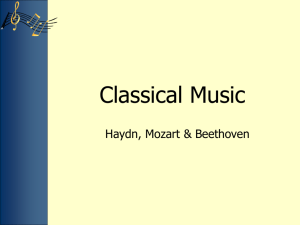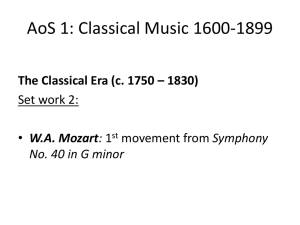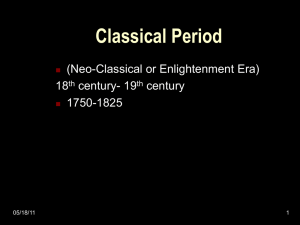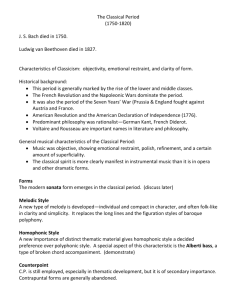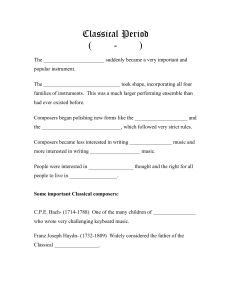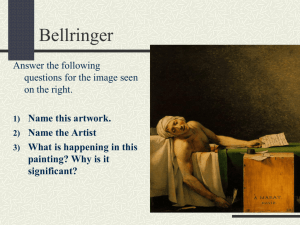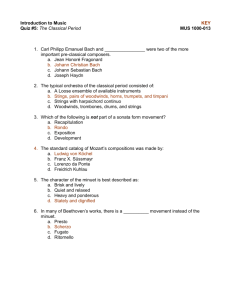File - Ms Jones' GCSE Class
advertisement
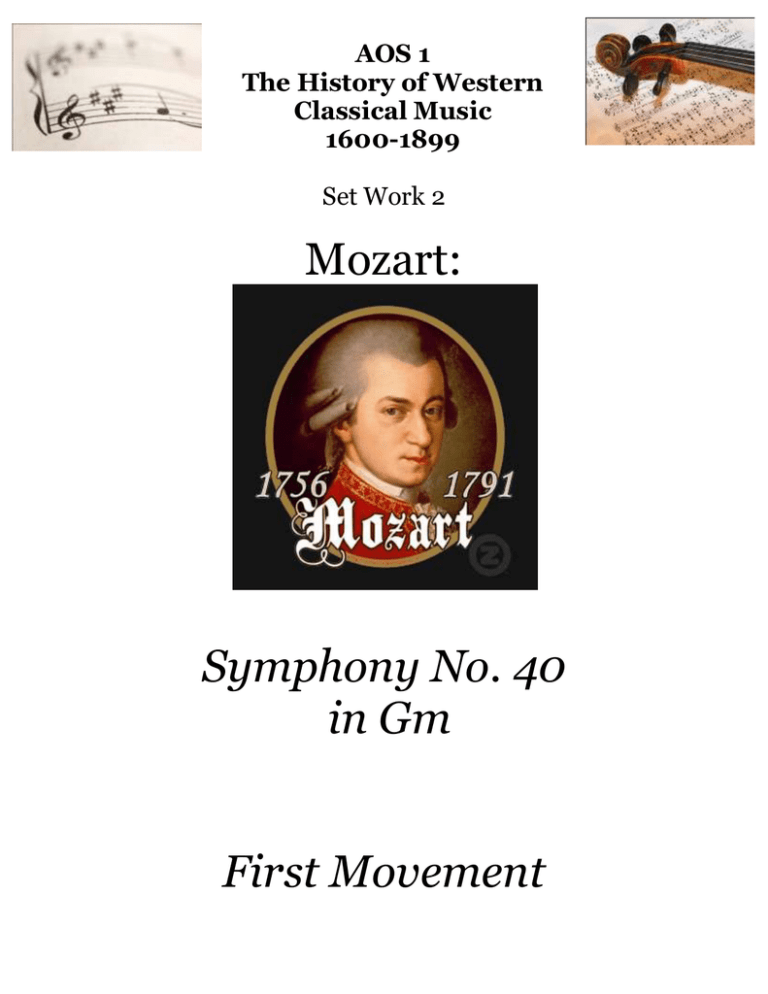
AOS 1 The History of Western Classical Music 1600-1899 Set Work 2 Mozart: Symphony No. 40 in Gm First Movement Classical Music 1750 - 1825 A deliberate move away from highly decorated and ornate Baroque characteristics. Music from this period echoes architecture of a clear cut and balanced structure, with a huge use of symmetry. Composers strived to create Music of Beauty KEY FEATURES Simpler textures, Oft en Homophonic – Melody and accompaniment became the standard. Polyphonic/ monophonic used for specific purposes Simpler melodies - repetition and even phrases with lots of ‘question and answer’ structures. Expression markings given in scores including crescendos and diminuendos Increased use of wind instruments, though the melody is still mainly in the strings. The wind instruments tend to fill out the harmonies The Piano – (replaced harpsichord) ability to produce lots of dynamics, became most important solo instrument for Classical composers (not used in orchestra) Clarinet Invented Piano sonatas – Work for solo instrument and piano Simple two and three part forms became building blocks for all Classical forms String quartets – Two violins, viola and cello Sonata form invented More contrast within a piece- dynamics, keys, tunes, rhythms New musical genres –Sonatas for solo instrument, concerto, string quartets and the Symphony Symphony developed as a musical structure – huge orchestral works Classical Orchestra Strings, flutes, oboes, clarinets, bassoons, trumpets, horns, piano –much larger orchestra with better developed instruments. Woodwind becomes a self contained section Listen out for, Classical symphony orchestra – strings, woodwind, brass and timpani String quartets Graceful, clear cut melodies with clearly marked phrases Pleasant harmonies Solo concertos – soloist plus orchestra Alberti bass – Split chordal accompaniment Famous composers Wolfgang Amadeus Mozart (1756-91) Franz Joseph Haydn (1732-1809) Ludwig Van Beethoven (1770 – 1827) Mozart – 1756-1791 Born in Austria A child prodigy (young person of exceptional talent) Toured Europe giving performances to royalty from the age of 6 Lived in Salzburg, Paris and Vienna Died a pauper at the age of 35 Left over 600 compositions! What is a Symphony? A Large Scale orchestral work invented during Classical Period. Early symphonies were like Italian Sinfonias – for strings and continuo, in 3 movements – slow – fast – slow. The contrast in tempo translated to first symphony of 3 movements. It then continued to develop throughout 19th and 20th Centuries and still today. As the symphony progressed it had 4 movements as follows. First Movement Second Movement Fast Tempo- Allegro or similar Usually in Sonata Form Slow Tempo – Andante Forms included Ternary and Theme and Variations Third Movement (not in early symphonies) – Triple time Slightly slower than 1st movement Form -Minuet and Trio Fourth Movement Fastest Tempo Form- Rondo, Sonata or variations Haydn, Mozart, Beethoven and Schubert – All Classical composers wrote Symphonies. Beethoven wrote 9 while Haydn wrote over 100! Mozart composed about 50 symphonies with many being commissioned by royalty or aristocrats. The most likely place to hear a symphony would be in a concert hall. During the Romantic era, Symphonies became longer and more elaborated. The Symphony that this movement is from is 25 minutes in total The word Symphony is Italian for ‘Sounding together’. – Classical orchestra used in a symphony is all four instrumental families sounding together. Symphony No. 40 (1788) Facts.......... Key of G minor 4 movements Use of sonata form for 1st, 2nd and 4th movements 3rd movement is a minuet & trio Each movement has a different tempo The first movement is molto allegro which means _________________________ No trumpets or timpani – unusual for a Classical Symphony! A perfect example of well balanced melody lines, written in regular phrases of four or eight bars – question and answer phrases. Also called Periodic / Regular phrasing Regular Cadences define structure Classical Musical structures were usually balanced and symmetrical – Shown in this piece by using Sonata Form Homophonic texture is used allot in this piece, although Polyphonic sections are also used. Cantabile playing – legato and singing style Chords are used to help structure also. Based on the main chords 1, 4, 5 and also 2 and 6 Contrast was shown using a variety of keys, melodies and dynamics Growing orchestra and redundancy of continuo/harpsichord Looking at the melody below, this is heard at the beginning of the extract. Fill in the missing notes in bars 3 and 4. N.B. You will more than likely get a question like this in the first part of your listening exam. Look at the following signs/abbreviations. List one place where you can find them in the score and write down what they mean: ‘div.’______________________________________________________________________ ‘1’ _______________________________________________________________________ ‘a 2’ ______________________________________________________________________ sf _______________________________________________________ tr ________________________________________________________________________ legato ____________________________________________________________________ staccato ___________________________________________________________________ crescendo __________________________________________________________________ Listen to the music and follow the score. You will notice that it is in 3 main sections, what happens in the final section? _________________________________________________________________________________________________________ _________________________________________________________________________________________________________ _________________________________________________________________________________________________________ What you have heard is a movement in Sonata Form – the most important large musical structure in the Classical period. Sonata Form Two fundamental ideas in Sonata form are Repetition and Contrast. It developed from originally from Binary Form. First Section Exposition – Themes are ‘exposed’ / heard for 1st time First Subject – Always in Tonic or home key. Usually most lively or rhythmic. Transition / Bridge Passage – A short linking section, used to modulate the Music to the 2nd Subject. Second Subject – Contrasts in both mood and key. The key is related – e.g relative Major/minor or dominant key. Codetta / Closing Section – Brings the section to a close, uses material already used and may modify it. Second Section Development – Themes go through a number of twists and turns A development of one or both subjects. It can be based on the whole melody or a fragment or few notes from the theme. Example of features – Sequencing – varying the pitch, Imitation, with slight changes, Making notes longer and shorter – Augmentation and Diminution, New rhythms, Inversion – turning the tune upside down. It will also feature various keys, deliberately avoiding the tonic and dominant. Constantly changing with a restless feel. Third Section Recapitulation – Themes are ‘Recapped’ First Subject. This is repeated but sometimes slightly modified – shorter, added ornaments Transition / Bridge. This balances with the Exposition, but this time is not needed for a modulation Second Subject – Stays in the tonic key this time. Again, sometimes modified – changing which instruments play the theme etc Coda - Not essential but will often appear, particularly if there has been a codetta–to balance the work out. The coda is longer than the codetta. It is the finishing section, largely in the tonic key, bringing in material from the whole piece, slightly varied. N.b The whole Exposition is often repeated so that the listener will become familiar with the two subjects before the development STRUCTURE AND TONALITY Complete the chart below by adding in the bar numbers: Section Sub-section Description Key First subject A melody characterised by a falling motif. Played by strings first Gm Bridge passage Full orchestra playing Bb Second subject A melody with descending chromatic patterns, shared between strings and woodwind Bb (relative major) Codetta Reinforces the key centre Bb Exposition Development Based on the first subject, which is developed and fragmented First subject Extended Bridge passage Moves through various keys generally around the circle of 5ths First subject is repeated with some variation Gm Full orchestra playing Gm Second subject is repeated with some variation Gm Recapitulation Second subject Coda Repeated perfect cadences to finish the piece. Gm Bar MELODY Most of the melodies are made up of 4 bar phrases that sound like questions and answers. Many of them are scalic. What does this mean? _________________________________________________________________________________________________________ _________________________________________________________________________________________________________ _________________________________________________________________________________________________________ HARMONY This is a typical Classical symphony and therefore the harmony is ______________ throughout. There are however times when Mozart uses chromatic chords such as the diminished 7th and augmented 6th – mostly used in the development section where the tonality is more ambiguous. What harmonic device does Mozart use in the opening bars? __________________________________________________________________________ He also uses this in bars 17-20, but what is different this time? __________________________________________________________________________ A popular feature of Classical music was the use of the circle of 5ths as a chord progression. Mozart uses this in a number of places but most notably in bars 57-58 and bars 203-209. Its clever design is very helpful in composing and harmonizing melodies, building chords, and moving to different keys within a composition. RHYTHM, METRE AND TEMPO Describe the tempo and metre of this movement in two sentences: _________________________________________________________________________________________________________ _________________________________________________________________________________________________________ _________________________________________________________________________________________________________ _________________________________________________________________________________________________________ The rhythms are fairly simple though there are some use of dotted rhythms and syncopation to help create momentum and interest. Can you find one example of each within the score? Dotted rhythm __________________________________________________________________________ Syncopation __________________________________________________________________________ TEXTURE As with much music from the Classical period the main texture in this piece is homophonic. He does however use dialogue between instruments. Look at the second subject in bars 44-48 – first you hear the strings which is then answered by the WW. What does Mozart do to this Q&A phrase in bars 52-55? _________________________________________________________________________________________________________ _________________________________________________________________________________________________________ _________________________________________________________________________________________________________ INSTRUMENTS Wind, Brass, Strings. No continuo – Larger number of Wind instruments in Classical Music could fill harmonies instead of a keyboard instrument. Clarinet was invented around 1730 – 2nd version included the clarinets. Mozart does not use Trumpets or drums, which were usually included in the classical orchestration. Notice how some of the instruments are in Bb and G. They are called Transposing instruments. Notice that there are two horns in different keys – one in Bb and one in G. As well as the clarinet and piano being invented in the Classical period the horn was also another new arrival. The type of horn used at this time was called a natural horn. It had no valves and therefore relied on the musicians lips to create different notes. The notes were limited to their harmonic range. A horn in Bb would therefore only be able to play the notes Bb D F and C. A horn in G would be able to play G B D and F. In order to maximise the number of pitches Mozart had 2 horns – one in Bb and the other in G. A natural horn with different sizes of crooks, the crooks did the job of transposing the instrument. DYNAMICS Complete the chart below by filling the general dynamics for each section: Section Sub-section First subject Exposition Bridge Second subject Development First subject Recapitulation Bridge Second subject Dynamics AoS 1 Mozart: Symphony No. 40 When you have learnt the meaning of the following keywords for the above set work write them in here: Terms Symphony Sonata Form Exposition Development Recapitulation 1st and 2nd Subject Bridge Passage Orchestra Sequence/ Sequential movement Chromatic movement Major and Minor Dominant Pedal Circle of 5ths Diatonic Definitions

